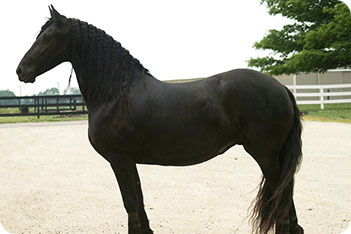
Dressage - Flying Changes
Horse Training
From: Horse Training
See also: Leg Yield | Shoulder In| Half Pass| Rider Aids| Piaffe | Passage| Travers| Pirouette| Counter Canter

Dressage - Flying Changes
In Dressage a flying change is a change of canter lead which occurs in the horses moment of suspension in between canter strides where the horse will appear to skip from one canter lead to the other.
A series of Flying Changes are called Tempi - Changes and can have four or less strides of canter in between each flying change with one time changes being the most demanding of changes as there are no canter strides in between each of the flying changes.
Preparation For Flying Changes
- Your horse should already be well schooled, balanced on both canter reins and able to perform counter canter and lateral work.
- Your horse should also be responding well to collection and be attentive to the riders canter aids.
Aids For A Flying Change
- Warm your horse up in walk, trot and canter and ensure that the horse is freely moving, balanced, supple, engaged behind and being attentive to the riders aids.
- Pick up left lead canter and canter across the long diagonal ensuring that the horse remains straight. Collect the canter and then when you feel that the horse is in the moment of suspension in between canter strides then you ask for the change, the following of which will all be asked for within this 2 second moment of suspension.
- Flex the horse a little to the right using your inside rein but maintain balance with your outside left rein which will also lightly collect the horse in preparation for the change.
- At the same time your weight should transfer, so that you have more in your inside right seat bone with your upper body also following through to the right with this movement (watch out for leaning to the inside).
- Your left leg will move behind the girth to initiate the change of hind and your inside right leg will remain on the girth to ensure that their is sufficient impulsion maintained throughout the change.
- Your horse will land on the new right right canter lead and should be ridden positively away.
- The exercise should be repeated on the opposite rein.
- Flying Changes are demanding on your horses mind and body and so start of slowly to build up your horses confidence, coordination and strength and also to maintain the quality of each of the changes.
Flying Change Exercises
Some horses find quite a challenge to get the hang of so here are some different exercises which can help to encourage a change of lead to occur;
- Place a pole on the diagonal near to the corner marker where you will be asking for the change. The pole will help to encourage the hind leg to pick up and change behind. The pole can also be raised a few inches on the inside which will further encourage the change to occur. Once your horse gets used to the aid for a flying change the pole can be removed.
- A figure of eight is another excellent fling change exercise where the horse has to remain in balance before and after the flying change. If necessary you can add a wooden pole over X to begin with to assist with the change.
- When you become more proficient you can add flying changes into a serpentine with the changes occurring on the centre line.
- Another excellent flying change exercise which I find very useful is to ride a half 10 or 15 m circle that returns to the track, this exercise allows you to add in some counter canter on returning to the track if you think your horse is anticipating riding the change.
- When you can ride changes anywhere on demand you can then start riding tempi changes.
- Start off with four time tempi changes and then progress to two and then one time changes.
Flying Change Faults
- Late behind is a sign that the horse has not managed to bring their hind legs forward at the same time as the front which the horse will often correct about a stride later. You will need to ensure that the canter is forwards, active and straight beforehand and that the aid for the Flying Change is being precisely ridden.
- Going crooked can be caused by the horse anticipating the change or by the riders using aids that are too strong. An useful exercise is to try riding the change on the long side of the school in between the wall and a pole, you can do this by placing the pole on an inner track parallel to the wall to form a tunnel. You may need to make the gap between the wall and the pole quite wide to begin until the horse is used to it and then follow the change by riding straight away afterwards. Some horses anticipate a change of direction and so go crooked in preparation for a change of rein, so always ride straight afterwards.
- Resistance or tension can be due to the horse not clearly understanding the riders aids, if this is the case then you will need to go over your canter aids and transitions to regain your horses confidence. Another reason the horse may resist is if the riders aids are too strong which can cause the horse to become tense. Some horses find flying changes quite stressful and can become tense through anxiety or just through excitement so you may need to introduce changes gradually.